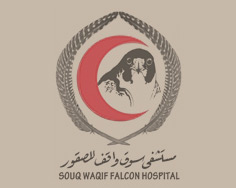Common Diseases in Falcon
« BackAspergillosis

It is a common fungal infection among falcons. Very difficult to treat and probably will lead to death of the infected falcon. The gyr and hybrid gyr falcons are among the highest susceptible to be infected by this disease. The most likely reason is that these falcons are imported from cold climate countries where this kind of infection is very rare. Therefore the falcon will have low immunity to this type of fungus as they will have had no previous exposure to it. Another factor is the exhaustion of these falcons in the imported countries especially in the gulf countries due to the hot humid weather which increases the chances of infection by this disease. Other factors include living conditions – which most of the time is kept hot and humid, without ventilation and unhygienic, these conditions are perfect for fungi to multiply and grow, infecting the falcons that occupy them. Probable infections by other diseases precipitate the infection by these fungi for example lung worms, air sac infections, lead poisoning, bad nutrition, low vitamin A and B and the abuse of antibiotics in addition to different environmental factors like high humidity dust and degraded organic materials.
Aspergillosis is transmitted to falcons either by inhalation or by direct contact with infected birds or the use of contaminated tools and equipment like water baths.
It may take up to six weeks for symptoms to appear after infection and it could take months to appear if the infection is of chronic type. The most common symptoms are the change of colour of the faeces to green, difficulty in breathing, loss of appetite, regurgitation of food, reduction of weight, weakness and lethargy and the increase in the urine material in the faeces (white material), inability to fly, poor performance in exercise and training, swelling and obstruction of the nose, thick excretion from the nostrils that are mostly blocked and swelling of the nasal sinuses. If the infection reaches the nervous system the infected falcon will show irregular movement, twisting of the neck and head, imbalance, tremors in the head, deviation of the tail to one side and convulsions.
Diagnosis of Aspergillosis may be made in different ways importantly (examining stamina) which means comparing the falcons respiration rates between resting and activity and the time taken for the rate of respiration to return to the resting. This can be done by exposing the falcon to stress for half a minute then allowed to rest for 2 min and then check the respiration rate. If resting rate does not return the probability of infection is suspected.
Other symptoms which may appear on the falcon may also play an important role in the diagnosis, in addition to, the use of medical equipment like endoscopy to examine the abdominal cavity, the lungs and the air sacs and the rest of the internal organs. X-ray investigation may be used to check the integrity of the lungs and the air sacs and the rest of the internal organs. Biopsies can be taken while performing an endoscopy to verify in the laboratory and confirm the infection.
Treatment of Aspergillosis is very difficult and most of the time ineffective. And the reason is that the site of infection is usually surrounded by a fibrous wall preventing the reach of medicine to the site of infection. However some cases will recover, especially if in the initial stages.
Treatment of Aspergillosis can be classified into 4 levels depending on the severity of the symptoms.
Grade 1 – the infected falcon usually shows decreased appetite, reduction in weight, reduction in activity and regurgitation. Diagnosis of this grade can be done using endoscopy and treatment is possible in this grade.
Grade 2 – in addition to all symptoms mentioned in grade 1 the falcon will show difficulty in breathing. Diagnosis can be made by endoscopy and by taking a biopsy from the legion to be cultured in the laboratory. Treatment in this grade is sometimes possible and sometimes unsuccessful.
Grade 3 – the falcon shows severe symptoms of difficulty breathing, inability to do any action during flight and training, loss of appetite and severe reduction in weight. Diagnosis can be done by endoscopy, confirming the presence of legions on the internal organs and can also be easily see in x-rays. Treatment in this grade is unsuccessful.
Grade 4 – all symptoms mentioned above present and rapid deterioration of condition will lead to death.
Prevention from infection of this disease can be achieved by avoiding any factors that leads to lowering the immunity of the falcon for example exhaustion, poor nutrition, bad management (unclean cages and rooms, contaminated equipment, bad ventilation etc).
Regular inspection of the falcon to confirm no infection especially before buying or importing the falcon and in case of suspicion the falcon should be immediately isolated and the use of all equipment should not be shared with other falcons.










